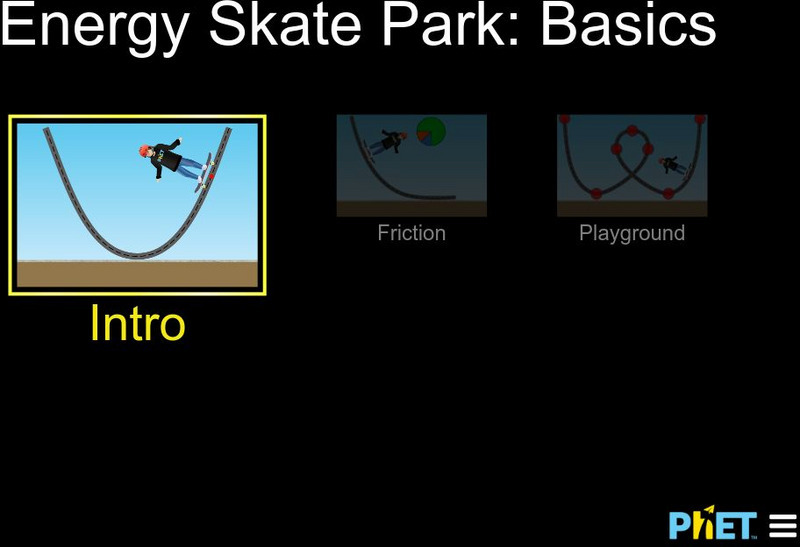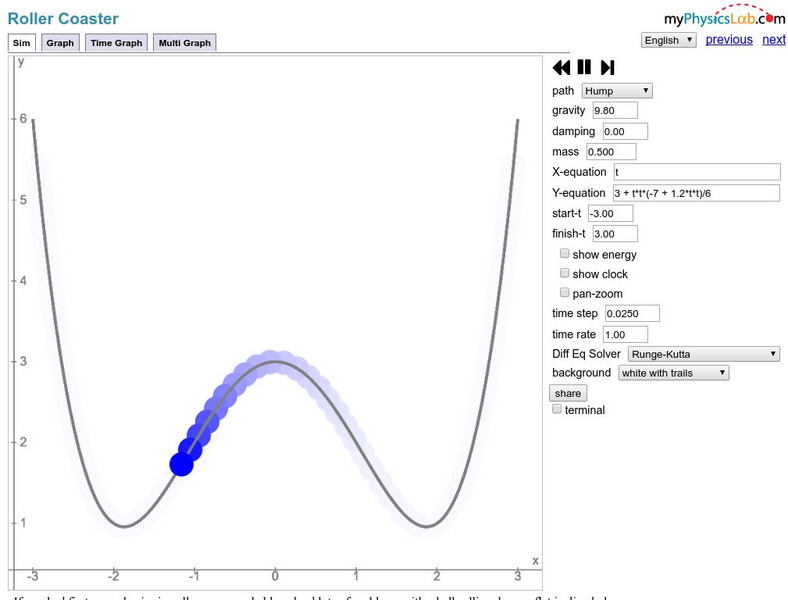Hi, what do you want to do?
PHET
Energy Skate Park
Apply the concepts of conservation of energy to a skater to introduce a fun way the concepts apply to real life. Scholars build tracks, ramps, and jumps then analyze the various types of energy and friction. For an added challenge,...
PHET
Energy Forms and Changes
Is the ice cooling down the water or is the water melting the ice? Here is a simulation that explores thermal energy transfer with iron, brick, and water. It demonstrates the flow of energy and what happens when each material is either...
PHET
Energy Skate Park: Basics
Keep calm and half pipe. An exciting simulation teaches pupils about energy transfer from potential to kinetic and thermal as a skater moves through a half pipe or other track. After a brief introduction, scholars can build their own...
CK-12 Foundation
Ski Jump
What are the three types of energy a ski jumper uses? If you said potential, kinetic, and heat, then you are correct. Scholars adjust the jumper's mass, jumper's form, and height of the start line in the simulation to display graphs of...
Physics Classroom
Law Enforcement - Explosions
How do law enforcement officers determine the strength of an explosion based on the movement of objects around the point of origin? Scholars inspect the relative mass and velocities of two cars before and after an explosion. They perform...
CK-12 Foundation
Roller Coaster
Roller coasters rely on both kinetic and potential energy, but how much total energy does a roller coaster need? Scholars vary the mass of a coaster and the height of the initial hill. Graphs showing the types of energy and total energy...
PHET
Masses and Springs
Have you ever stretched out a Slinkie so much it wouldn't go back to its original shape? Slinkies, like all springs, follow Hooke's Law. A simulation uses springs and masses to demonstrate kinetic, potential, and thermal energy. It...
CK-12 Foundation
Loop-the-Loop
What prevents a roller coaster from falling when it goes upside down? Scholars experiment with a roller coaster simulation controlling the mass of the coaster, the height of the hill, and the radius of the loop. They learn which factors...
CK-12 Foundation
Ballistics Tests
How did scientists measure the speed of incredibly fast things before the invention of high-speed photography? Scholars virtually perform ballistics tests to discover the process. They control the rifle type, bullet mass, and target...
CK-12 Foundation
Wind Turbine
Scientists know wind is a renewable resource, but is it an efficient one? Scholars adjust the propeller diameter on a wind turbine, the wind speed, and the conversion efficiency within range to learn about the efficiency of these...
Concord Consortium
Concord Consortium: Stem Resources: Atoms and Energy
Online activity walks learner through exploration of kinetic and potential energy using animations. Through graphs, a quantitative connection is made between the movement and the energy involved. This information is then related to the...
CK-12 Foundation
Ck 12 Exploration Series: Simulations: Physics: Ski Jump
[Free Registration/Login Required] A simulation where students learn about the conservation of energy in a ski jump.
University of Colorado
University of Colorado: Ph Et Interactive Simulations: Energy Skate Park
Explore kinetic, potential, and thermal energy as you send a skateboarder along several pre-built tracks, then design your own. Charts and graphs show the distribution of the different forms of energy, illustrating how the total energy...
University of Colorado
University of Colorado: Ph Et Interactive Simulations: Masses and Springs
Use this interactive, animated lab to explore conservation of mechanical energy.
Concord Consortium
The Molecular Workbench Database: Energy Conservation in Chemical Reactions
Follow the energy conversion from potential to kinetic in this interactive activity that explores total energy in chemical reactions.
University of Colorado
University of Colorado: Ph Et Interactive Simulations: Masses & Springs
Hang various mass weights on spring scales while you adjust the spring stiffness and damping in this online activity. Slow down the action, take it to another planet, or watch the amount of potential, thermal, and kinetic energy.
University of Colorado
University of Colorado: Ph Et Interactive Simulations: The Ramp
Which object takes more energy to push up a ramp: a file cabinet, a refrigerator, a piano, or a sleepy dog? Find out in this ramp simulation when you change the angle of the incline, change the objects, or change the friction on the ramp.
Physics Aviary
Physics Aviary: Energy Loss Lab
This lab is designed to have students investigate the amount of energy lost by a ball when it bounces. Students will change the starting height of the ball and see how this affects the amount of energy lost and the percent of the...
Physics Aviary
Physics Aviary: Guided Energy Loss Lab
This guided lab is designed to have students investigate the amount of energy lost by a ball when it bounces. This guided activity is meant to be used as a pre-lab for students who will do this lab live. Students will get a certificate...
University Corporation for Atmospheric Research
Ucar: Earth's Energy Balance
See how Earth's temperature would change if the Sun's brightness increased or dimmed or if Earth's albedo was different.
CK-12 Foundation
Ck 12 Exploration Series: Simulations: Physics: Ballistics Tests
[Free Registration/Login Required] Practice with the concepts of conservation of momentum and energy by analyzing a special case of the ballistic pendulum.
Annenberg Foundation
Annenberg Learner: Design a Roller Coaster
An interactive lesson where students design and build their own virtual roller coaster. Choose the height of the hills. the shape of the hills. and loop to find out if you successfully used physics concepts to pass the safety and fun...
Other
My Physics Lab: Roller Coaster
Create a simplified roller coaster with this simulation by creating a track shape for a ball to travel on. Students can change gravity and damping. Site includes equations to help students understand what is happening in the simulation.























